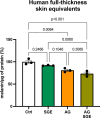Sage extract and ascorbic acid derivative inhibit melanogenesis via downregulating keratinocyte-derived GM-CSF
- PMID: 40493564
- PMCID: PMC12151418
- DOI: 10.1371/journal.pone.0325242
Sage extract and ascorbic acid derivative inhibit melanogenesis via downregulating keratinocyte-derived GM-CSF
Abstract
Salvia officinalis (sage) extract has demonstrated potential as a functional ingredient for skin care application. However, its effect and mechanism in regulating skin pigmentation remain largely unclear. This study investigated the effects of sage ethanol extract (SGE) on melanogenesis and its underlying molecular mechanisms. Treatment with SGE in a human skin equivalent model (3D-skin) suppressed melanin production. To clarify the mechanism of action, the study focused on senescence-associated secretory phenotype (SASP) factors, which are implicated in age-related pigmentation changes. q-PCR and ELISA analyses showed that SGE inhibits melanogenesis by suppressing the expression of granulocyte-macrophage colony-stimulating factor (GM-CSF), a known SASP factor in keratinocytes. Interestingly, a similar effect was observed with L-ascorbic acid 2-glucoside (AG), previously identified as a tyrosinase inhibitor. Importantly, p38 and JNK MAP-kinase were identified as upstream regulators of GM-CSF that are suppressed by SGE. These findings provide new insights into how SGE and AG regulate pigmentation via keratinocyte-derived GM-CSF, highlighting their potential in modulating skin tone and pigmentation through cellular signaling pathways.
Copyright: © 2025 Kubo et al. This is an open access article distributed under the terms of the Creative Commons Attribution License, which permits unrestricted use, distribution, and reproduction in any medium, provided the original author and source are credited.
Conflict of interest statement
The authors have declared that no competing interests exist.
Figures




References
MeSH terms
Substances
LinkOut - more resources
Full Text Sources
Medical
Research Materials

